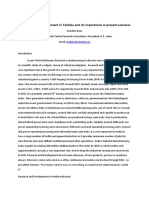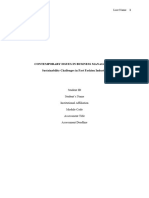Study of The Role That AI Can Play in The Sustainable Fashion Business
Study of The Role That AI Can Play in The Sustainable Fashion Business
Uploaded by
alimubashshir201995Copyright:
Available Formats
Study of The Role That AI Can Play in The Sustainable Fashion Business
Study of The Role That AI Can Play in The Sustainable Fashion Business
Uploaded by
alimubashshir201995Original Title
Copyright
Available Formats
Share this document
Did you find this document useful?
Is this content inappropriate?
Copyright:
Available Formats
Study of The Role That AI Can Play in The Sustainable Fashion Business
Study of The Role That AI Can Play in The Sustainable Fashion Business
Uploaded by
alimubashshir201995Copyright:
Available Formats
International Journal of Scientific Research in Engineering and Management (IJSREM)
Volume: 08 Issue: 02 | February - 2024 SJIF Rating: 8.176 ISSN: 2582-3930
Study of the role that AI can play in the Sustainable Fashion
Business
Authors:
1
Syed Mubashshir Ali, Universal business School, Karjat, Raigad, Maharashtra,410201
Email Address: Syedmubashshirali52@gmail.com
2Yash Shrawane, Universal Business School, Karjat, Raigad, Maharashtra,410201
Email Address: yashshrawane4@gmail.com
3Pragati Verma, Universal Business School, Karjat, Raigad, Maharashtra,410201
Email Address: Pragativerma08@gmail.com
4Soniya Vashisth, Universal Business School, Raigad, Maharashtra,410201
Email Address: soniavashisth7@gmail.com
Abstract:
This study investigates the potential application of artificial intelligence (AI) in the field of sustainable
fashion by streamlining the production of clothing and incorporating trend analysis. By researching current
fashion trends and consumer preferences to identify the most well-liked apparel patterns and designs, the
article seeks to optimise supply and demand while reducing surplus production. Fashion garment production
can be optimised to fulfil customer demand while minimising waste and lowering costs by incorporating
trend research into the manufacturing process. Companies may now invest in clothing concepts that will sell
thanks to AI trend forecasting, which reduces some of the uncertainty and human error that now hinder trend
forecasting. The fashion industry is infamous for its detrimental effects on society and the environment,
including creation of waste and pollution. While the fashion industry has started to adopt more sustainable
practises, AI has the ability to quicken the process by offering creative answers to some of the sector's most
pressing problems. The study looks at a number of AI-related case studies in the fashion sector, including the
use of predictive analytics to cut waste and streamline supply chains, computer vision to enhance textile
recycling, and natural language processing to encourage openness and moral work practises.
The paper also examines how AI could revolutionise the fashion business and hasten the shift to a more
ethical and sustainable future. The report also highlights the necessity for careful evaluation of these
concerns as the fashion industry develops by posing significant ethical and social implications for AI.
© 2024, IJSREM | www.ijsrem.com DOI: 10.55041/IJSREM28523 | Page 1
International Journal of Scientific Research in Engineering and Management (IJSREM)
Volume: 08 Issue: 02 | February - 2024 SJIF Rating: 8.176 ISSN: 2582-3930
INTRODUCTION:
The fashion sector of the global economy has experienced rapid growth in recent years and is now one of the
most active. The fashion industry is the second-largest polluter in the world, contributing significantly to
greenhouse gas emissions, water pollution, and landfill waste, hence its growth has been harmful to the
environment and society. Furthermore, there is a lot of labour exploitation going on, with many employees
receiving meagre pay and bad working conditions. Because of this, sustainability has gained significance,
and many fashion companies are putting sustainability programmes into place in order to lessen their negative
effects on the environment while continuing to be profitable.
Artificial intelligence (AI) is being used to optimise production and manufacturing processes in the fashion
sector to attain sustainability. AI is a technology that can carry out tasks and imitates human intelligence. that
frequently call for cognitive processes related to perception, reasoning, and learning. Fashion companies may
increase sustainability while maintaining profitability by utilising AI. In order to better understand how AI
may be used in sustainable fashion enterprises, this research paper will focus on how it can be used to
optimise production and manufacturing processes.
There are several ways to use AI to optimise the production and demand of fashion products. Utilising
predictive analytics, which entails studying previous data to forecast future demand, is one approach. To
estimate demand for diverse products, AI systems can examine a variety of elements like consumer
behaviour, trends, weather patterns, and social media trends.
By forecasting demand and identifying slow-moving goods, AI can also be used to improve inventory
management. By ensuring that they only produce products that are in high demand, this can help firms lower
their inventory costs and increase cash flow.
The article examines how AI technology might be applied to improve the sustainability of the fashion
industry as well as the issues that must be resolved in order for it to be widely adopted. This study explores
the advantages and drawbacks of using artificial intelligence (AI) to the fashion industry in order to promote
sustainable development. In conclusion, AI technology has the potential to be extremely important to the
sustainable growth of the fashion industry, and this paper can serve as a roadmap for companies looking to
integrate AI into their sustainability projects. The purpose of this research paper is to examine the potential
impact of artificial intelligence (AI) on the sustainable fashion industry, particularly
with regard to streamlining production and manufacturing procedures to increase sustainability while
retaining profitability.
Impact of Fashion Industry on Pollution
• 92 million tons of textile waste is produced every year.
• It contributes to 4-5% of the pollution of the human being on planet earth.
• Hence it is very important to reduce the pollution created by fashion industry
as it is impacting the sustainability of planet earth.
© 2024, IJSREM | www.ijsrem.com DOI: 10.55041/IJSREM28523 | Page 2
International Journal of Scientific Research in Engineering and Management (IJSREM)
Volume: 08 Issue: 02 | February - 2024 SJIF Rating: 8.176 ISSN: 2582-3930
Research Objectives:
This research paper's main goal is to investigate how AI may benefit the sustainable fashion industry. The
paper's specific objectives are to:
1. Analyze the possible advantages of applying artificial intelligence in the fashion sector for sustainable
growth.
2. Improving clothing manufacturer supply and demand in the fashion market.
3. Trend analysis of the most recent trends in the fashion industry.
Research Methodology:
This study will examine how AI may contribute to the sustainable fashion industry using a qualitative
research methodology. A review of the existing academic papers, books, and reports on AI and sustainable
fashion will be done as part of the project. A case study analysis of fashion companies that have previously
incorporated AI for sustainable development will also be part of the project.
The research methodology will involve the following steps:
1. Literature review: To determine the possible advantages and difficulties of utilising AI in the fashion
industry for sustainable growth, a thorough evaluation of the body of knowledge on AI and sustainable
fashion will be done.
2. Case study analysis: To determine if AI in the fashion sector is effective for sustainable development,
a case study analysis of enterprises that have already used the technology will be carried out.
3. Data analysis: To get insights into the potential role that AI might play in the sustainable fashion
industry, the data gathered from the literature research and case study analysis will be analysed.
4. Findings and suggestions: We will suggest ways for fashion companies and policymakers to apply
AI based on the data analysis findings of sustainable development.
Literature Review:
Sustainability issues in the fashion business are well-documented in the literature. Numerous studies have
emphasised the industry's considerable environmental effects, which include waste, greenhouse gas
emissions, and water pollution. The production and manufacturing process involves a large number of
partners, making the industry's supply chain complex. As a result, everyone involved in the fashion
industry—manufacturers, suppliers, retailers, and consumers—must work together to achieve sustainability.
In recent years, the application of AI in the fashion sector has drawn more attention. Numerous research has
investigated how AI might be used to streamline production and manufacturing procedures, ultimately
cutting waste and boosting effectiveness. AI can assist in locating patterns in data and offer perceptions that
can guide judgement. AI, for instance, may be used to forecast consumer demand, improve inventory control,
and cut supply chain waste.
© 2024, IJSREM | www.ijsrem.com DOI: 10.55041/IJSREM28523 | Page 3
International Journal of Scientific Research in Engineering and Management (IJSREM)
Volume: 08 Issue: 02 | February - 2024 SJIF Rating: 8.176 ISSN: 2582-3930
AI can also be utilised to increase the textile industry's sustainability. Textile manufacture is a highly
resource-intensive process that uses a lot of water and energy. By using less water and energy during
production, AI can improve efficiency and lessen its negative effects on the environment. AI can also be
employed to find sustainable resources and modern alternatives to conventional industrial processes.
Following is the research paper which were reviewed for literature study.
1. (Chen, I.-F.; Lu, C.-J 2021) This research paper explores the use of k-means clustering, extreme
learning machines, and support vector regression to construct cluster-based models for demand forecasting
in the fashion industry. The results showed that integrating clustering analysis can improve prediction
accuracy, making it a suitable demand forecasting method for the fashion industry. The study emphasizes the
importance of accurate demand forecasting in the highly competitive and rapidly changing fashion industry,
and how AI can help improve sustainability by reducing waste and optimizing supply chains.
2. (Xianyi Zeng · Yingmei Xing · Zhenzhen Xu 2023) This paper proposes a new interactive design
approach for customized garments using machine learning techniques, including RBF ANN, GA, PNN, and
SVR. It was tested on leisure pants customization and found to be more accurate, fast, intelligent, and
sustainable than existing approaches. It also establishes an effective communication channel among
consumers, fashion designers, pattern designers, and garment producers.
3. (Shaik Vaseem Akram , Praveen Kumar Malik , Rajesh Singh, 2022) This study examines how the
fashion industry can promote sustainable consumption and production by integrating digital technologies
such as IoT, AI, blockchain, AR, and VR. The paper explores different studies that implemented these
technologies in the fashion industry and provides recommendations for future enhancements.
4. (Eunjung Shin , Sohyun Kim 2022) This study focuses on the impact of fashion Artificial Intelligence
(AI) curation services on promoting sustainable consumption. Women in their 20s and 30s living in the
metropolitan area were surveyed via an online questionnaire from March 29 to June 4, 2021. Participants
were instructed to take photos of their clothes using the "Style Bot" application and store them in a virtual
wardrobe before answering the questionnaire using the AI recommended coordinating function. The study
found that convenience, speed, and usefulness positively affect the use of clothes, while promptness had no
effect. Clothing utilization was found to have a positive effect on environmental sustainability, which in turn
had a positive effect on satisfaction. The study concludes that an in-depth understanding of the properties of
fashion AI curation services could promote the
active use of clothes and contribute to environmental sustainability. These findings could help develop and
improve fashion AI curation services, ultimately promoting sustainable consumption in the fashion industry.
5. (Yoon Kyung Lee,2021) This study proposes a sustainable real-time fashion system (RTFS) using
information communication technology, AI, and virtual environments for active customers in 3D clothing
production systems. The RTFS is aimed at automating and democratising product customisation and
© 2024, IJSREM | www.ijsrem.com DOI: 10.55041/IJSREM28523 | Page 4
International Journal of Scientific Research in Engineering and Management (IJSREM)
Volume: 08 Issue: 02 | February - 2024 SJIF Rating: 8.176 ISSN: 2582-3930
personalisation processes and proposing individual designs with perfect styles and measurements. 3D fashion
products in the RTFS supply chain are entirely digital, saving time and money with sampling and tracking
capabilities, secured and trusted with personalised service delivery.
6. (Shi, M.,Chussid, C.,Yang, P.,2021)
Fashion trends change rapidly, making trend forecasting crucial in the industry. However, traditional
forecasting is costly and time-consuming. This study proposes an A.I. approach to abstract fashion image-
based information quickly and accurately. The A.I. model was trained to identify garments and classify
clothing attributes from runway photos and videos, allowing it to summarize fashion trends.
7. (Xing, Yingmei,Xu, Zhenzhen ,Bruniaux,n ,2023) This paper proposes a sustainable 3D reverse
garment design approach that uses machine learning techniques to create personalized fashion products. It
involves drawing a 3D basic garment on a scanned mannequin and using a probabilistic neural network to
predict garment fit, followed by genetic algorithms and support vector regression to estimate and control
garment parameters. A comprehensive evaluation characterizes the relationship between the consumer and
the designed garment profile, resulting in a personalized garment. This approach offers a cost-effective and
eco-friendly solution for developing personalized fashion products.
8. (Lee, Yoon Kyung,2022) Artificial intelligence (AI) technology is expected to provide sustainable
solutions in the fashion industry to increase the productivity of fashion products and decrease unnecessary
energy consumption, such as the environmental problems caused by inventory handling and overproduction.
The fashion system used for designing is a complex and creative domain. As a result, this study investigated
the practical application of AI in fashion design which in turn should enable designers to focus on creative
work, improve their work, and use AI in creative designs related to complex systems. First, the creation of
GANs (generative adversarial networks) and human design was compared. Second, complex system
elements involved in AI design creation were defined.
9. (Pereira, Artur M,Moura, J. Antão B, Costa,2022) The fashion industry, being a large and global
industry with sustainability and digitalization concerns, can benefit from Decision Support Systems (DSSs).
Decision-making in online fashion retail is complex due to changing customer preferences and product
availability. Artificial Intelligence techniques can be used to construct customer models (CMs) to inform
personalized decisions. The combination of CMs with recommender systems (RSs) is increasingly used for
personalized product recommendations. However, research on enhancing CMs for e-commerce or other
decision-making chain domains is limited. This paper provides a systematic review of literature on fashion
CMs and identifies research topics for future study.
10. (Satinet, Chloe, Fouss, François,2022)
The fashion industry lacks a clear and comprehensive label for environmentally sustainable products, making
it challenging for sustainability-focused consumers to identify such products. This paper proposes using
supervised machine learning tools to develop a model for assessing the environmental sustainability of
clothing products throughout their life cycle. The model is trained on a dataset of clothing products and their
© 2024, IJSREM | www.ijsrem.com DOI: 10.55041/IJSREM28523 | Page 5
International Journal of Scientific Research in Engineering and Management (IJSREM)
Volume: 08 Issue: 02 | February - 2024 SJIF Rating: 8.176 ISSN: 2582-3930
life cycle characteristics, achieving an average accuracy of 91% using the random forest algorithm. The
resulting model provides a quick and accurate assessment of clothing products' environmental sustainability
with limited data available to online retailers.
Based on the abstract of the research paper, the potential findings of the study could include:
The research paper examines the potential role of AI in the sustainable fashion sector and emphasises how
trend analysis of clothing may be used to optimise the production of fashion garments. Fashion garment
production can be optimised to fulfil customer demand while minimising waste and lowering costs by
incorporating trend research into the manufacturing process. In the article, uses of AI in the fashion sector
are illustrated, including the use of predictive analytics to cut waste and streamline supply chains, computer
vision to enhance textile recycling, and natural language processing to encourage openness and moral work
practises.
The research paper's key discovery is that some of the uncertainty and human mistake that currently hinder
trend predicting is eliminated by AI trend forecasting. allowing businesses to invest in fashion ideas that will
sell. This may result in less waste and excess manufacturing, lowering the harmful effects of the fashion
industry on the environment and society. The study also emphasises that while the fashion industry has started
to adopt more sustainable practises, AI has the ability to quicken this process by offering creative solutions
to some of the sector's most pressing problems.
The ability of AI to revolutionise the fashion industry and hasten the transition to a more ethical and
sustainable future is another significant result. The paper, however, raises questions about the ethical and
societal implications of AI in the fashion business, highlighting the need for careful examination of these
issues as the sector develops. For instance, the use of AI may result in job losses for individuals employed in
the fashion industry, particularly for those performing manual labour, and it may worsen already existing
disparities in the sector.
Overall, the research report contends that AI has much potential for the sustainable fashion sector, but careful
thought is required to ensure its ethical and responsible application. The article makes a significant
contribution to the current debate on AI's role in the fashion industry emphasises the need for more research
and development to solve the problems and opportunities this technology brings to the industry.
How AI can create sustainability in fashion industry.
By streamlining the manufacturing of fashion items and putting trend analysis into it, AI can promote
sustainability in the fashion sector. AI can identify the most popular clothing styles and designs by studying
current fashion trends and consumer preferences; this information can then be utilised to optimise the supply
and demand of fashion goods. This minimises waste and lowers expenses while also ensuring that businesses
are creating clothes that there is a market for.
Additionally, by forecasting consumer demand for certain products, AI can help businesses optimise their
supply chains and lower overproduction. AI algorithms can reliably forecast future demand by assessing
historical sales data and other pertinent data, enabling businesses to produce only what they are certain will
© 2024, IJSREM | www.ijsrem.com DOI: 10.55041/IJSREM28523 | Page 6
International Journal of Scientific Research in Engineering and Management (IJSREM)
Volume: 08 Issue: 02 | February - 2024 SJIF Rating: 8.176 ISSN: 2582-3930
sell. This can lower the quantity of unsold stock and, ultimately, stop surplus production, one of the biggest
sources of waste in the fashion business.
AI can also be utilised to enhance textile recycling. By identifying and classifying textiles according to their
material makeup, computer vision, a type of AI technology, can increase the effectiveness and efficiency of
textile recycling. This can encourage a circular economy in the fashion sector and lessen the amount of textile
waste that is dumped in landfills.
Another sort of AI technology called natural language processing can be utilised to advance ethical work
practises and transparency in the fashion business. In order to find possible problems with employment
practises and sustainability, this technology can be used to examine data from a range of sources, including
social media, news articles, and government reports. This can assist businesses in proactively addressing
these problems, improving their procedures, and fostering greater transparency across the board.
In conclusion, AI can contribute to sustainability in the fashion sector by streamlining the manufacturing
process, lowering waste, and fostering greater openness and ethical behaviour. Companies may make
clothing that are in demand, reduce waste, and ultimately lessen the damaging effects of the fashion industry
on society and the environment by utilising AI technology.
Conclusion:
This study paper concludes by highlighting the potential contribution of AI to the sustainable fashion sector.
Fashion garment production can be optimised to fulfil customer demand while minimising waste and
lowering costs by incorporating trend research into the manufacturing process. By using AI to predict trends,
some of the uncertainty and human error that now hamper trend forecasting are reduced, allowing businesses
to invest in clothing concepts that will be successful.
The case studies studied in this article demonstrate the creative solutions that AI can offer to some of the
major difficulties facing the fashion industry, such as waste reduction and supply chain optimisation. The
industry may hasten the transition to a more ethical and sustainable future by implementing AI technology.
The article also poses significant ethical and social implications for AI in the fashion business. Artificial
intelligence (AI) use may lead to job displacement and a loss of human expertise, which could have a bad
effect on communities and people individually.
Additionally, there is a chance that AI-driven decisions would not take critical ethical factors into account,
such the influence on the environment and fair labour practises.
Because of this, it is crucial to carefully weigh the possible dangers and benefits as the fashion industry
moves forward with the implementation of AI technology and to make sure that ethical and social issues are
incorporated into decision-making processes. By doing this, the sector may use AI to promote sustainability
and beneficial effect while minimising any potential drawbacks.
© 2024, IJSREM | www.ijsrem.com DOI: 10.55041/IJSREM28523 | Page 7
You might also like
- eCXD Labs PDFDocument285 pageseCXD Labs PDFRachid Moyse PolaniaNo ratings yet
- B1 - Liquid Level Control SystemDocument17 pagesB1 - Liquid Level Control Systemmoon star angel100% (1)
- Elena Sarnavskaya DELTA M2 2016 Lesson PlanDocument29 pagesElena Sarnavskaya DELTA M2 2016 Lesson PlanAsya100% (1)
- The Evolution of Relationship MarketingDocument9 pagesThe Evolution of Relationship MarketingPagla HowaNo ratings yet
- AI For SustainabilityDocument250 pagesAI For Sustainabilitylvdang36No ratings yet
- Factor Analysis Research MethodologyDocument11 pagesFactor Analysis Research Methodologythwishaa100% (3)
- Moderation and Mediation in Process MacroDocument8 pagesModeration and Mediation in Process MacroSajid hussain awanNo ratings yet
- Brand Storytelling in the Digital Age: Theories, Practice and ApplicationFrom EverandBrand Storytelling in the Digital Age: Theories, Practice and ApplicationNo ratings yet
- AI-Powered Supply Chain Optimisation and The Integration Within The Fashion Industry: A Literature ReviewDocument6 pagesAI-Powered Supply Chain Optimisation and The Integration Within The Fashion Industry: A Literature ReviewInternational Journal of Innovative Science and Research TechnologyNo ratings yet
- A Detailed Review of Artificial Intelligence Applied in The Fashion and Apparel IndustryDocument21 pagesA Detailed Review of Artificial Intelligence Applied in The Fashion and Apparel IndustryTharun RajNo ratings yet
- Brand Fashion Project 2Document16 pagesBrand Fashion Project 2Anh Trần MinhNo ratings yet
- fin_irjmets1682324420Document7 pagesfin_irjmets1682324420Tram Nguyen Do HuyenNo ratings yet
- Annotated Bibliography 1 1Document6 pagesAnnotated Bibliography 1 1api-742883363No ratings yet
- Sustainable Planning Strategies in Supply ChainDocument21 pagesSustainable Planning Strategies in Supply ChainDương NguyễnNo ratings yet
- MGT 480Document7 pagesMGT 480Mr. ArafatNo ratings yet
- Group 5 Assignment EditedDocument14 pagesGroup 5 Assignment EditedJunaid Ali MurtazaNo ratings yet
- Bharati Rathore 2017 3aDocument10 pagesBharati Rathore 2017 3akvpriya05No ratings yet
- Research and Development in Textiles and Its Importance in Present ScenarioDocument5 pagesResearch and Development in Textiles and Its Importance in Present ScenarioTowhid Ul IslamNo ratings yet
- Mikiyas Zerfu ArticleDocument20 pagesMikiyas Zerfu Articleestifanos demekeNo ratings yet
- Application of Artificial Intelligence in Supply Chain: Revolutionizing Efficiency and OptimizationDocument10 pagesApplication of Artificial Intelligence in Supply Chain: Revolutionizing Efficiency and OptimizationIBTISSAM SAHHALNo ratings yet
- Management in The Garment IndustryDocument5 pagesManagement in The Garment IndustrymulunehnowNo ratings yet
- Mishra 2020Document19 pagesMishra 2020Ngọc Bảo Nhi NguyễnNo ratings yet
- QiR Final (Sarah)Document19 pagesQiR Final (Sarah)Riza AnimationNo ratings yet
- 965-Article Text-2441-1-10-20240326Document20 pages965-Article Text-2441-1-10-20240326ducanhday3103No ratings yet
- Research Proposal 3 AssignmentDocument10 pagesResearch Proposal 3 Assignmentarundhattispatil22No ratings yet
- Big Data in Fashion IndustryDocument7 pagesBig Data in Fashion Industrysonia josephNo ratings yet
- (Textile Science and Clothing Technology) Rajkishore Nayak - Lean Supply Chain Management in Fashion and Textile Industry-Springer (2022)Document321 pages(Textile Science and Clothing Technology) Rajkishore Nayak - Lean Supply Chain Management in Fashion and Textile Industry-Springer (2022)Israel AliagaNo ratings yet
- Sustainability Challenges in Fast Fashion IndustryDocument19 pagesSustainability Challenges in Fast Fashion IndustryjohnmorriscryptoNo ratings yet
- Occupational Health Problem Among Laundry Workers of Denim Industries in BangladeshDocument11 pagesOccupational Health Problem Among Laundry Workers of Denim Industries in BangladeshKawser AhmedNo ratings yet
- Case Study - BA - Textiles and Apparel IndustryDocument13 pagesCase Study - BA - Textiles and Apparel IndustrySanju RodriguezNo ratings yet
- Demand Forecasting in The Fashion Industry: A ReviewDocument6 pagesDemand Forecasting in The Fashion Industry: A ReviewSamarth TuliNo ratings yet
- FDK 1Document7 pagesFDK 1richakashyap1801No ratings yet
- Document 8Document12 pagesDocument 8sakshi bhatiaNo ratings yet
- Lean ManufacturingDocument37 pagesLean ManufacturingRajiv Ranjan0% (1)
- Need of Adoptive Textile Research Centre Needed in IndiaDocument4 pagesNeed of Adoptive Textile Research Centre Needed in IndiaMerugu RachanaNo ratings yet
- For Print Research PaperDocument9 pagesFor Print Research Paperaatif khanNo ratings yet
- IJCRT2403802Document10 pagesIJCRT2403802sumit28072003No ratings yet
- Comparative Analysis of Operational Strategies Zara vs. H&M: Authors' NotesDocument6 pagesComparative Analysis of Operational Strategies Zara vs. H&M: Authors' NotesjunaidNo ratings yet
- AI-Driven Marketplaces and Price Prediction Tools For Rag Pickers: Enhancing Economic Opportunities in Africa's Circular EconomyDocument10 pagesAI-Driven Marketplaces and Price Prediction Tools For Rag Pickers: Enhancing Economic Opportunities in Africa's Circular EconomyTara GonzalesNo ratings yet
- Customer Satisfaction of Kent Water Purifier 1Document3 pagesCustomer Satisfaction of Kent Water Purifier 1Pallavi PalluNo ratings yet
- A Study of Supply Chain Management of TeDocument22 pagesA Study of Supply Chain Management of Teশাইখ উদ্দীনNo ratings yet
- Boutique, Supply Dynamics - 2017 - Al-Mamun PDFDocument8 pagesBoutique, Supply Dynamics - 2017 - Al-Mamun PDFAyon KhanNo ratings yet
- Intellectual Capital On Sustainability For Garment IndustryDocument8 pagesIntellectual Capital On Sustainability For Garment Industryraghu7676No ratings yet
- AI in TextileDocument16 pagesAI in Textileisfi23001No ratings yet
- Impacts of Internet of Things On Supply Chains: A Framework For WarehousingDocument11 pagesImpacts of Internet of Things On Supply Chains: A Framework For WarehousingViet Bui DucNo ratings yet
- Assessment 3-V1Document13 pagesAssessment 3-V1Gailani OmerNo ratings yet
- Digital Manufacturing Technology for Sustainable Antropometric Apparel with authorDocument4 pagesDigital Manufacturing Technology for Sustainable Antropometric Apparel with authoryopimalagola.2022No ratings yet
- Urkund Report - Plagiarism NOT checkedSHUBHANGI DASH 1720357.docx (D64868194) PDFDocument60 pagesUrkund Report - Plagiarism NOT checkedSHUBHANGI DASH 1720357.docx (D64868194) PDFShetty RakshithNo ratings yet
- Challenges: A Study of Textile Industry in India: Vanita Vishram Women's College of Commerce, SuratDocument7 pagesChallenges: A Study of Textile Industry in India: Vanita Vishram Women's College of Commerce, SuratSuraj ParmarNo ratings yet
- Applsci 11 07549Document12 pagesApplsci 11 07549nikhil krNo ratings yet
- Jurnal - Rencana Bisnis Pakaian Kyara Dengan Analisis Model Bisnis KanvasDocument17 pagesJurnal - Rencana Bisnis Pakaian Kyara Dengan Analisis Model Bisnis KanvasLuthfia LuhuringkaniaNo ratings yet
- Sustainability Benefits of RFID Technology in The Apparel IndustryDocument14 pagesSustainability Benefits of RFID Technology in The Apparel IndustryBảo TrâmNo ratings yet
- CSANAK Edit AI For FAshion TZG 2020Document8 pagesCSANAK Edit AI For FAshion TZG 2020Arti vermaNo ratings yet
- Fast FashionDocument9 pagesFast Fashionharshitbansal184507No ratings yet
- Impact of Technology in E Retailing Operation - 2015 - Procedia - Social and BehDocument7 pagesImpact of Technology in E Retailing Operation - 2015 - Procedia - Social and BehSALHI NADIRNo ratings yet
- Oztemel-Gursev2020 Article LiteratureReviewOfIndustry40AnDocument56 pagesOztemel-Gursev2020 Article LiteratureReviewOfIndustry40AnMarko BrkicNo ratings yet
- Reference Model For Apparel Product Development: Independent Journal of Management & Production March 2017Document32 pagesReference Model For Apparel Product Development: Independent Journal of Management & Production March 2017nidhi bhatiaNo ratings yet
- Does Sustainability Make Business SenseDocument9 pagesDoes Sustainability Make Business Sensejeetjain02No ratings yet
- Case Study On Profit Planning of Textile Industry Using Linear Programming ApproachDocument10 pagesCase Study On Profit Planning of Textile Industry Using Linear Programming ApproachVamshee KrishnaNo ratings yet
- Digitalizing Supply ChainsDocument35 pagesDigitalizing Supply ChainsAuliya FatihinNo ratings yet
- Final Exam Supervision of Instruction Jeannitte OnanDocument6 pagesFinal Exam Supervision of Instruction Jeannitte OnanJeannitte Gelos OnanNo ratings yet
- Proyecto de InglesDocument14 pagesProyecto de InglesJesus AmadoNo ratings yet
- HE Design, Esra Belhaj, 13.10.2020Document48 pagesHE Design, Esra Belhaj, 13.10.2020Esra BelhajNo ratings yet
- Exp 4.1specific Heat CapacityDocument4 pagesExp 4.1specific Heat CapacityNazirah Rohanip100% (4)
- Astrophysics IGCSE 9-1 Physics PDFDocument31 pagesAstrophysics IGCSE 9-1 Physics PDFMehrab100% (3)
- Artificial Intelligence For The Diagnostics of GasDocument35 pagesArtificial Intelligence For The Diagnostics of Gasعين العربNo ratings yet
- CMEA HS Strings Audition Repertoire 2025 2028Document4 pagesCMEA HS Strings Audition Repertoire 2025 2028dshen24No ratings yet
- w7 SysTick ExamplesDocument11 pagesw7 SysTick ExamplesHayriye KAYMAZNo ratings yet
- Functionalism Antecedent InfluencesDocument33 pagesFunctionalism Antecedent InfluencesDe MarNo ratings yet
- Manifest NonUFSFiles Win64Document2 pagesManifest NonUFSFiles Win64Boon SwaggleNo ratings yet
- Week 9Document27 pagesWeek 9MirzaNo ratings yet
- Refrigerant Unit Lab ReportDocument19 pagesRefrigerant Unit Lab Reportakmal100% (2)
- Bachelor Thesis Wireless CommunicationDocument45 pagesBachelor Thesis Wireless CommunicationRangga Putra AidaniNo ratings yet
- Molecular Diagnosis in Breast Cancer: Mini-Symposium: Breast PathologyDocument12 pagesMolecular Diagnosis in Breast Cancer: Mini-Symposium: Breast PathologyOber Van Gómez LópezNo ratings yet
- Eclipse SW Rel - 07-08-55 Customer Release Notes (Low Latency) - 01may2015Document9 pagesEclipse SW Rel - 07-08-55 Customer Release Notes (Low Latency) - 01may2015Sohaib SalihNo ratings yet
- CBSE - Senior School Certificate Examination (Class XII) Results 2017Document1 pageCBSE - Senior School Certificate Examination (Class XII) Results 2017Suman Kumar MishraNo ratings yet
- MariaDB - Tutorial For BeginnersDocument37 pagesMariaDB - Tutorial For BeginnersCesar ManriqueNo ratings yet
- Vlookup Index Match - StudentsDocument17 pagesVlookup Index Match - StudentsRahul DudejaNo ratings yet
- Si Ci 100 Ques With SolnDocument20 pagesSi Ci 100 Ques With SolnJason WestNo ratings yet
- Unit 9Document45 pagesUnit 9TRAN THI KIM NGANNo ratings yet
- Tier List Bulu MonsterDocument20 pagesTier List Bulu MonsterGodiego AzuraNo ratings yet
- The Secrets of Trading Chart Patterns Like The Pros 29 Jan 24Document51 pagesThe Secrets of Trading Chart Patterns Like The Pros 29 Jan 24VERO NICANo ratings yet
- Dragon Ball Z - The Viz Media Translations - Dragon Ball Z v02 (2003) (Digital) (AnHeroGold-Empire) - PDF RoomDocument189 pagesDragon Ball Z - The Viz Media Translations - Dragon Ball Z v02 (2003) (Digital) (AnHeroGold-Empire) - PDF Roomakarshpandey2012No ratings yet
- Koha On Debian - Koha WikiDocument9 pagesKoha On Debian - Koha WikiPaolo BNo ratings yet
- Moving Display Using 8051 Micro ControllerDocument45 pagesMoving Display Using 8051 Micro ControllerMuraliKrishnaNo ratings yet
- OSPF Cheat SheetDocument1 pageOSPF Cheat SheetjuanNo ratings yet
- Cohesion and CoherenceDocument15 pagesCohesion and CoherenceSheenly DavidNo ratings yet

























































































